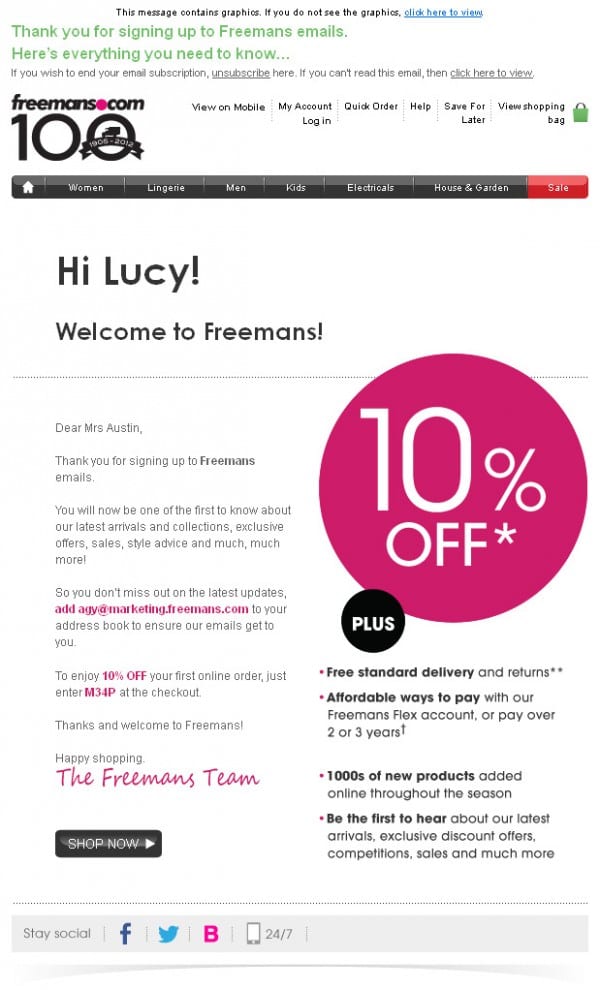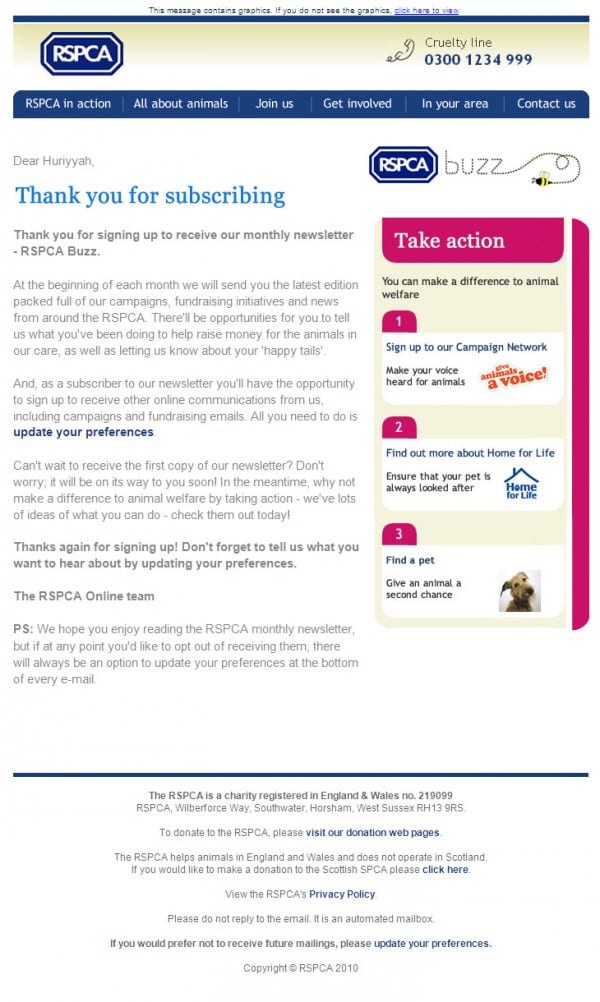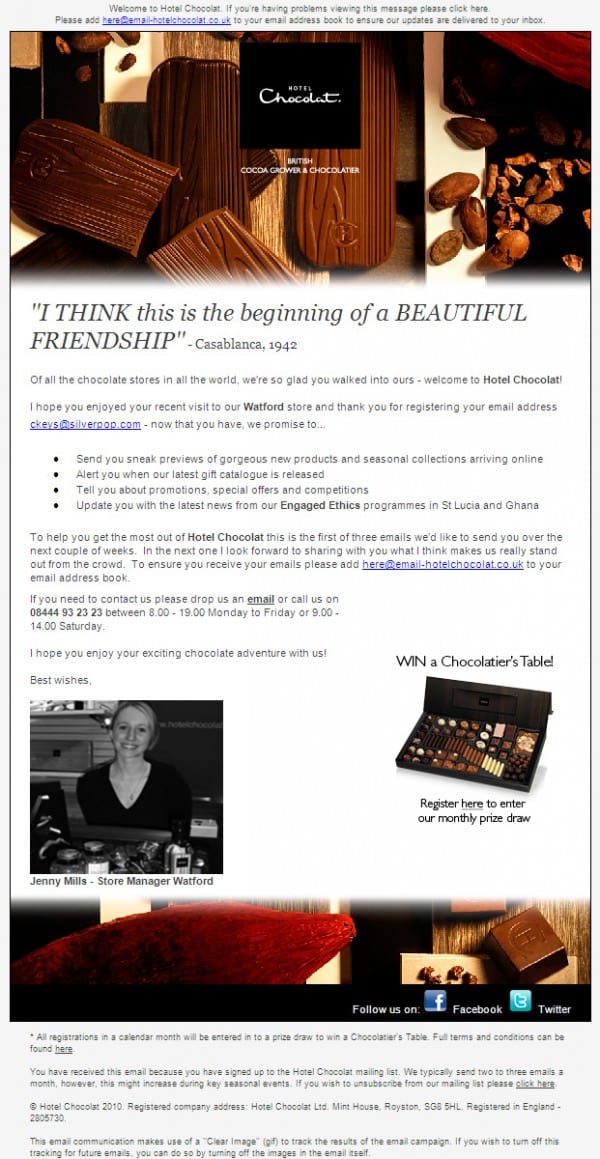An introduction to good practices for Welcome mails
To make your welcome emails work well, start by thinking through the range of motives that lie behind someone visiting your website and signing up for email? Let’s look at one example: A prospective customer has searched online, Facebooked friends for recommendations and ended up visiting your site, they haven’t purchased but have signed up for email.
Putting this into a real life context; a customer walks into your store, browses through several different items but doesn’t buy anything. In their way out they ask if you can send them further information about the products they were looking at.
Would a salesperson watch them walk away or would they take some time to tell them why they should buy from you, the great range that you have, present a few customer favourites or highlight your no quibble returns policy and help them make their mind up there and then?
This in essence is a Welcome Campaign.
If you’d said that in the example above you’d ask about what exactly they were interested in or how much they had to spend, then this is like using a Preference Centre to send more targeted welcome campaigns.
So if you’d be proactive in the real world, why wouldn’t you be so in the digital one? Given that if no initial welcome message is sent, the open rate can fall by 25% a few weeks after signing up, then the importance of a welcome campaign is clear. Open campaigns often have THE highest open rates of any type of email campaign since they're the first dialogue.
So what makes a great welcome campaign?
Let’s start with what consumers expect businesses to know:
- The types of products or services they like 64%
- The types of offers they like 61%
- Whether they’re a new or returning customer 54%
- Their communication preferences 47%
Source: Email Experience Council
Additionally, according to eConsultancy’s UK Email Marketing Statistics report, the majority of consumers (52%) sign up to email to receive discounts or other money off promotions.
Therefore these considerations have to be met by the welcome campaign and by extension the sign-up process.
- Discount or money off voucher
- Reference to product or service preferences
- Confirmation of communication preferences
By referencing recent purchase data and the source of the opt-in, for example identifying those who have signed-up via the checkout process, then another layer of sophistication can be added by recognizing this buyer behavior and tailoring the content around the product/service purchased, including any relevant cross sell content.
Welcome campaign examples
Here are three examples I have selected to show what makes a welcome campaign effective.
Freemans.com
 One of the standout elements on the Freemans welcome email is their use of the preheader “…Here’s everything you need to know”, not only does it say ‘Thanks’ and set expectations on content, it highlights this text and makes it unmissable.
One of the standout elements on the Freemans welcome email is their use of the preheader “…Here’s everything you need to know”, not only does it say ‘Thanks’ and set expectations on content, it highlights this text and makes it unmissable.
The highlighting is extended to the personalisation and “Hi Lucy!” is a big friendly welcome.
There is also a 10% discount incentive, promoted very visibly within the email, as a reward for signing up and quite deliberately the key USPs for shopping at Freemans are bulleted below this, all helping to incentivise the initial purchase.

So this email clearly contains some great elements like the preheader, personalisation and whitelisting request, also it squarely hits the first point in the list above; but to fully address consumer expectations it should confirm product and communication preferences or direct the recipient to a place where these can be determined.
RSPCA
 The RSPCA also personalises its message and says ‘thanks’ for opting in. It also firmly sets expectations on frequency “At the beginning of each month…” and content “packed full of our campaigns, fundraising, initiatives and news...” At the end of this section the charity also provides the opportunity to “update your preferences” and tell them what it is that you’d like to receive.
The RSPCA also personalises its message and says ‘thanks’ for opting in. It also firmly sets expectations on frequency “At the beginning of each month…” and content “packed full of our campaigns, fundraising, initiatives and news...” At the end of this section the charity also provides the opportunity to “update your preferences” and tell them what it is that you’d like to receive.
The content also recognises the common motivations for opting in and reflects this in the navigation options shown e.g. “Get Involved” and the very strong call to action panel ‘Take Action’ showing how the recipient can make a difference.

The need to offer a discount isn’t applicable to this communication however it does a great job in setting expectations, providing opportunities to set preferences and addressing recipient motivations.
Hotel Chocolat
 A key element to this campaign is that it refers to the opt-in source, in this case, in the store in Watford and subtly changes the welcome message because of it, including the email address given during the opt-in process. This helps recall the opt-in moment, prevents the email form being disregarded as spam and confirms the legitimacy of the email.
A key element to this campaign is that it refers to the opt-in source, in this case, in the store in Watford and subtly changes the welcome message because of it, including the email address given during the opt-in process. This helps recall the opt-in moment, prevents the email form being disregarded as spam and confirms the legitimacy of the email.
It sets out expectations on content as an easily scanned bulleted list and frequency “this is the first of three emails…” in the next paragraph. So that recipients are clear on what they can expect in the next few emails and are primed to look out for these within their inbox.

There is a nod towards the consumers’ desire for a discounted promotion with the inclusion of the competition. Though this could be much more tightly integrated into the overall layout become the main call to action for the email.
Summary
The welcome campaign is a key part of every email programme, instantly thanking customers for their interest and by collecting and referencing a couple of data points, like preferences and opt-in location, it becomes a highly personalised and effective communication
To ensure the optimal performance of your campaign be sure to examine how well it:
- Addresses customer motivations
- References previous purchase behaviour
And determine if it:
- Offers a discount or money off voucher
- References product or service preferences
- Confirms communication preferences
This will reduce the number of customers walking out of the door, improve contact retention and most importantly increase revenue. So say ‘Hi’ to your potential new customers, find out what they’re interested in, recognise them from before and begin and give them what they want.
You’ll be surprised by the results.












